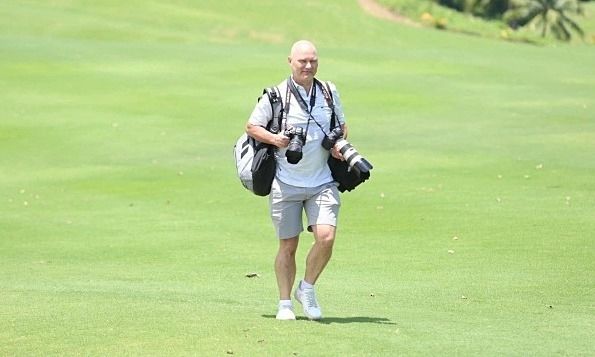
Before moving to Vietnam, the couple spent three years each in the U.K. and Poland working for pharmaceutical company Novartis. They had wanted a nomadic life, moving from one city to another across the world, until HCMC changed their mind.
Within two months they had fallen in love with the city. Van Zuijlen calls Thao Dien Ward a “mini international village” that still feels distinctly Vietnamese. They can hop on a motorbike to grab dinner, stop by a roadside café or dine at a high-end restaurant without needing reservations or worrying about the cost. The warm weather and open space add to the appeal.
While her husband is at work, van Zuijlen spends her time traveling, playing golf and tennis, joining women’s clubs, and volunteering. She visits an orphanage twice a week. “Easy to live in, affordable and full of friendly people. We both realized HCMC is a land of opportunity.”
In 2006 the couple opened a fully foreign-owned kindergarten, cementing their lifelong stay in the city. She reads extensively about Vietnamese history and culture, so much so that her staff often say she is more knowledgeable about the country than they are.
|
Joke Otter van Zuijlen in a Restaurant in Thu Duc, HCMC, August 2025. Photo by Courtesy of van Zuijlen |
Both are 68 now and have no plans to leave HCMC. Their biggest wish is for Vietnam to develop retirement communities with proper healthcare and mobility support so that they can spend their lives here in comfort.
More than 200,000 foreigners make HCMC their long-term home, more than three times the number in Hanoi. As of July 2023 there were 27,000 people with work permits, according to the city’s Department of Labor, Invalids and Social Affairs.
In June the Gensler Research Institute in the U.S. published the “City Pulse 2025: The Magnetic City” report, which ranked HCMC second in the world for retaining international residents. It found more than 61% of surveyed foreigners saying they had no intention of leaving.
The survey polled 33,000 residents in 65 cities to understand what drives people’s choice of where to live and to guide future urban planning.
Guillaume Rondan, director of Move to Asia, a company that helps foreigners relocate and invest in Asia, says HCMC keeps international residents with its dynamic business environment, affordable cost of living and modern lifestyle.
The city’s strategic location in Southeast Asia, growing middle class and competitive, high-quality workforce in tech, manufacturing and logistics all contribute to this appeal, he says.
Housing, food and healthcare in HCMC cost less than in cities like Singapore, Shanghai or Kuala Lumpur, while still maintaining high quality, he points out.
“HCMC has a young, ambitious population, always innovating, and combines modernity with tradition. Few cities in Vietnam offer this mix.”
Move to Asia’s data reveals that 55–60% of clients come to Vietnam with plans to live mid- or long-term. They often start businesses, apply for temporary residence cards or explore investment opportunities. The rest typically come for short-term projects, but many return to stay longer.
Over 80 percent of foreigners who stay in Vietnam for more than 24 months choose HCMC. For entrepreneurs, the city offers a balance of affordability, potential and quality of life.
|
Marcel Lenartz during a photography event in HCMC, March 2025. Photo by courtesy of Marcel Lenartz |
Marcel Lenartz, a Dutch engineer, first came to HCMC in August 1992 after hearing about it from several Vietnamese friends. In 1995 he returned for a short-term internship, but ended up staying for 30 years.
“It’s the people,” he says.
He once rode his bicycle through Can Gio, covered in mud and sweat, when he passed a wedding held by local farmers. They saw him and invited him to join the celebration. He hesitated, thinking he was too dirty, but they insisted and handed him a beer.
“People in HCMC, no matter their age or background, are friendly and sociable, something I don’t often see in Europe,” he says.
That same year Marcel chose to live with a Vietnamese family instead of the expat housing arranged by his company. He got to experience local life firsthand, from bathing with a bucket to eating home-cooked meals.
Over his 30-year stay Marcel has witnessed Vietnam’s growth and contributed in various ways. He helped build Saigon Water Park in 1997 and supported early software outsourcing firms, architecture companies and local running communities.
While his peers plan to retire in Da Nang, Hoi An, or Japan, Marcel remains committed to HCMC.
“There’s never a dull day here. Something new always surprises and excites me.”
-
Fizzi gets hair in the rain, falls in bunches, know how to do the best care of your hair?

-
Chewing saunf or drinking saunf water: Which is the healthier option

-
Dating Red Flags You Shouldn’t Ignore

-
Corn Side Effects: Avoid Eating Corn in These 5 Health Conditions

-
Mogra Plantation: Fill Your Garden with Fragrant Jasmine Blooms
